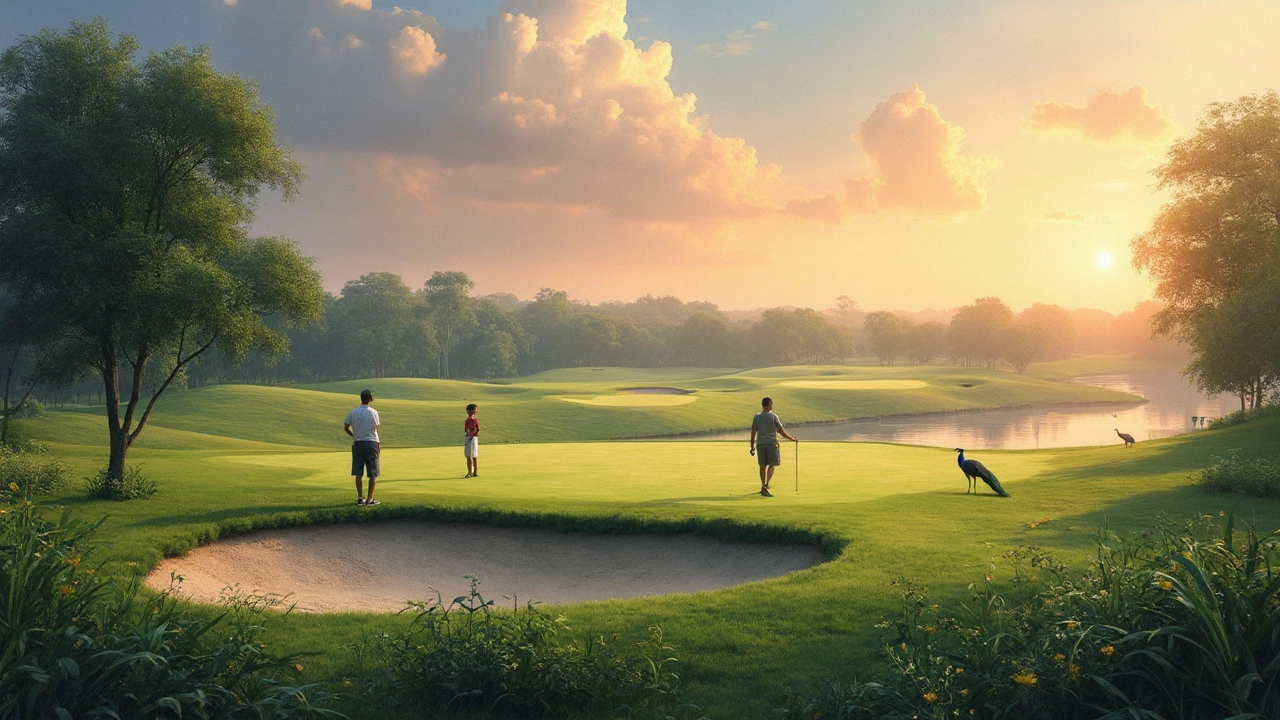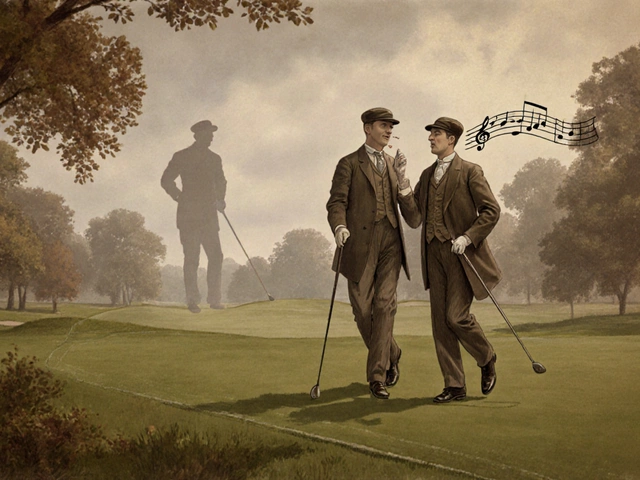So you've probably found yourself at a golf course, either for a leisurely game or maybe just exploring, and wondered, "What do we call this whole stretch of land?" Well, you're not alone. It turns out that the "field" for golf has a few interesting terms associated with it, and knowing them can definitely give you a leg up as you walk the greens.
A golf course is that sprawling mix of fairways, tees, bunkers, and greens that get grouped under one big term: a course. But each section has its own purpose and unique challenges. Imagine standing at a tee, trying to drive your ball perfectly onto the fairway. The fairway is that sweet strip of land leading you right up to the flag—and hopefully a swift path to the hole.
Understanding these terms not only makes you sound like you know your stuff but also helps you play with a bit more strategy. So let's break down more parts of a golf course and see why they matter to your game.
- The Basics of a Golf Course
- Parts of a Golf Course
- Understanding Golf Lingo
- Interesting Facts About Golf Courses
- Tips for Navigating a Golf Course
The Basics of a Golf Course
Alright, let's get to it. The whole expanse you walk on or drive through during a round of golf is called a golf course. But it’s not just random patches of grass. Everything is planned out to challenge and thrill golfers, whether you're playing your best game or just having fun.
First off, a standard golf course consists of 18 holes. Some smaller courses might have 9 holes, meaning players go around twice for a full game. Each hole has specific components: the tee box, fairway, rough, hazards, and the green. These components shape the experience and difficulty of the game.
Tee Box
This is where it all begins. The tee box is the starting point for each hole. It’s usually a flat area where you make your first swing. Different colored markers indicate the difficulty level, with forward tees generally being easier and back tees for advanced players.
Fairway
The fairway is what every golfer aims for right after the tee. It’s that glorious strip of closely mowed grass that provides the best path to the hole. Hitting your ball here is ideal for those next shots because of the smooth, even surface.
Rough and Hazards
The rough is the taller grass surrounding the fairways. It’s tougher to play from, so golfers prefer to avoid it. Then come the hazards—these include sandy bunkers and water features designed to make things tricky and test your skills. Watch out for these!
The Green
Finally, the green is the end goal of each hole. This part is where the hole is located, surrounded by the putting surface. The grass here is super short, so your golfing skills need to be precise to sink that final putt comfortably.
Now, if you’re getting deeper into the game, it might be interesting to know there are over 15,000 golf courses in the U.S. alone, each with its unique charm and challenges. Whether you're on a local course during your lunch break or at a championship course, you now have a clear picture of what makes up a golf course.
Parts of a Golf Course
When you step onto a golf course, you're entering a world filled with specific areas each designed to test your skills in a unique way. Let's break down some key parts of the course.
1. The Tee Box
The game kicks off here! The tee box is where each hole starts, and it's typically an elevated area giving you a good view down the fairway. You'll find markers that indicate where players can tee off, and choosing the right spot is crucial for setting up your first shot.
2. The Fairway
Ah, the fairway—this is the ideal landing strip for your ball after that powerful drive from the tee. It’s a well-manicured stretch of grass leading to the hole, and hitting your ball here is the goal. Staying on the fairway means avoiding those pesky roughs and sand traps.
3. The Green
The green is your ultimate target on each hole. It’s where you want your ball to end up so you can take a putt at the hole. The grass here is cut super short, allowing the ball to roll smoothly. That’s why putting requires a delicate touch and a keen eye for the slope.
4. Hazards: Bunkers and Water
No golf course would be complete without its share of hazards. Sand bunkers and water hazards are designed to challenge your precision and add complexity to the game. Whether digging your ball out of the sand or avoiding a detour into the water, these obstacles demand respect and strategy.
5. Rough Areas
If your shot doesn't quite go as planned, you might end up in the rough. This area has longer, thicker grass, making it trickier to hit clean shots. It's best to get back onto the fairway or the green as soon as possible!
A way to visualize the layout and navigate the course efficiently is invaluable. Here's a simple representation of common yardage indicators for typical holes:
| Par | Men's Yardage | Women's Yardage |
|---|---|---|
| 3 | 210 yards | 170 yards |
| 4 | 370 yards | 320 yards |
| 5 | 520 yards | 470 yards |
These distances offer a guideline, setting expectations for how you approach each hole. So next time you're on the course, you'll know exactly what you're facing and how to tackle it!

Understanding Golf Lingo
Getting the hang of golf terminology can feel like learning a whole new language, but it’s what ties the experience together when you’re out on the golf course. Knowing these terms doesn’t just help you sound cool during a game; it genuinely helps you play better.
Parts of the Golf Course
Let’s start with a few key areas:
- Fairway: This is the main part of each hole, a well-manicured stretch of grass leading from the tee to the green. It’s where you want your ball to land for an easier shot.
- Green: This is where the hole is located. The grass here is soft and short, perfect for rolling the ball into the cup.
- Tee Box: Where every hole starts. Players tee off here, and the ground is typically level for a smooth start.
- Bunker: Also known as a sand trap. Not your ideal landing spot, but every golfer must face it at some point.
Common Terms to Remember
When you're on a golf course, you might hear the following:
- Par: The number of strokes a skilled golfer is expected to take to complete a hole.
- Birdie: When you complete a hole one stroke under par. Celebrate it!
- Bogey: This one means you went one stroke over par. Oops, but it happens.
- Fore: Shouted when there’s a ball headed in someone’s direction. It’s your cue to duck!
Practical Tips for Using Golf Lingo
- Listen and learn. The best way to get comfortable with these terms is to hear them in action. Spend time with experienced players.
- Practice using them. Don’t feel silly using new terms. Repeated use will boost your confidence.
- Read up. Checking out golf forums or watching tournaments on TV can give you a better feel for how these words are applied.
So next time you're out there on those greens or the fairway, you'll know exactly what's happening and maybe even impress your fellow golfers with your knowledge!
Interesting Facts About Golf Courses
Let's dive into some cool trivia about these sprawling landscapes that make up the heart of golf. Did you know that the average professional golf course is about 7,200 yards long? That's over four miles of carefully curated terrain!
For fans of history, the oldest golf course in the world is the Old Course at St Andrews in Scotland, which dates back to the 15th century. It's like stepping back in time every time you walk those legendary fairways.
The Greens and Eco-Friendliness
Another interesting tidbit is about the greens. These aren't just perfectly manicured patches of grass. Many modern golf courses are focusing on eco-friendly practices, incorporating sustainable irrigation techniques to maintain those lush greens without wasting water. Golf courses around the world are now home to a variety of wildlife, transforming them into mini ecosystems where plants and animals can thrive.
Golf Courses and Economics
Did you know the biggest golf course in the world is the Mission Hills Golf Club in China? This mega-course boasts 12 pro courses, and if you played a round on each one, it would take you nearly two weeks!
Aside from being amazing pieces of land, golf courses play a significant role in the local economy. They're not just places to practice your swing; they're venues for tourism, employment, and even charity events.
- They often host major tournaments and events, bringing in visitors from around the globe.
- Many courses also double up as stunning venues for weddings and corporate events.
Unique Golf Course Features
A surprising feature of some golf courses is the presence of sand dunes or desert landscapes—especially in places like Arizona or coastal areas, where the natural scenery is integrated into the course design.
All these fascinating aspects add up to create the unique charm and challenge each golf course offers. Next time you're out on the field, take a moment to appreciate the blend of nature, sport, and human ingenuity all around you.

Tips for Navigating a Golf Course
Getting the hang of a golf course can be like mastering a new language. But with a bit of practice and a few handy tips, you'll feel right at home. Let's dive into some tricks to make your experience on the greens smoother.
Know the Layout
First off, always grab a scorecard or a course map. Most courses provide them to give you a bird's-eye view of the entire layout. It’ll help you understand where the fairways, bunkers, and greens are situated. Some courses even have digital maps you can access on your smartphone.
Club Selection is Key
Choosing the right club is crucial. For beginners, it might seem overwhelming at first, but here's a quick guide:
- Driver: Best for long-range shots, especially at the tee.
- Iron: Use irons 3-9 for a variety of medium-range shots.
- Wedge: Perfect for short shots and approaches to the green.
- Putter: When you’re on the green and just need that final nudge to get the ball in the hole.
Respect the Pace of Play
Nothing beats the camaraderie on a golf course, but remember, it's not just about you. Have a look at the pace of the group ahead and behind you. If you're moving a bit slow, it's always a good idea to let faster groups play through.
Mind the Weather
Weather can change the way a golf course plays. Windy conditions call for adjusting your swing and club choice, while a sunny day might mean the greens are faster. Keep an eye on the forecast and plan your game accordingly.
Stay Hydrated and Snack Smart
Lastly, remember to stay hydrated and keep those energy levels up. Packing light snacks, like nuts or a banana, can keep you going. And always have a water bottle handy. It's a long game, and keeping fueled can help you maintain your focus.


